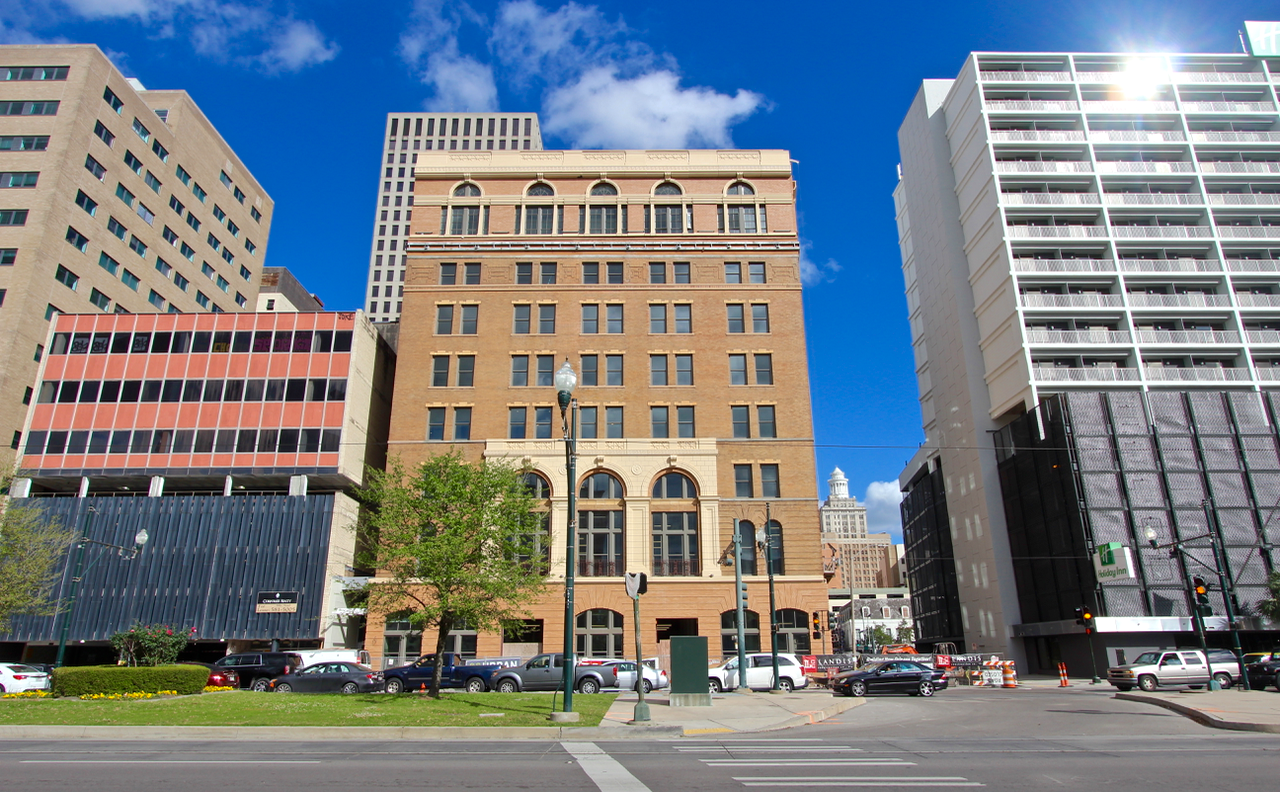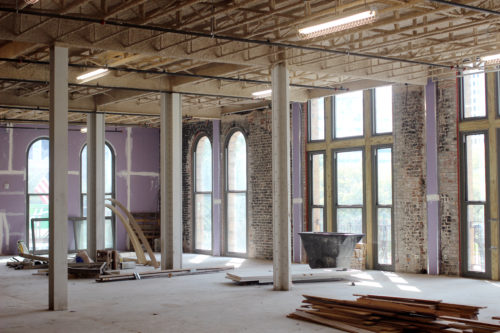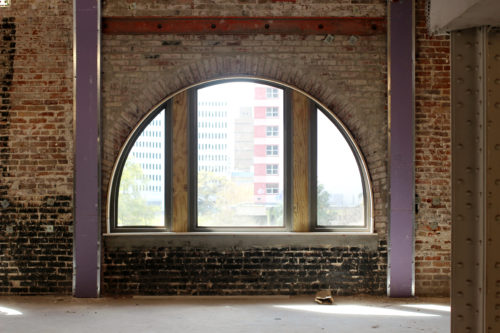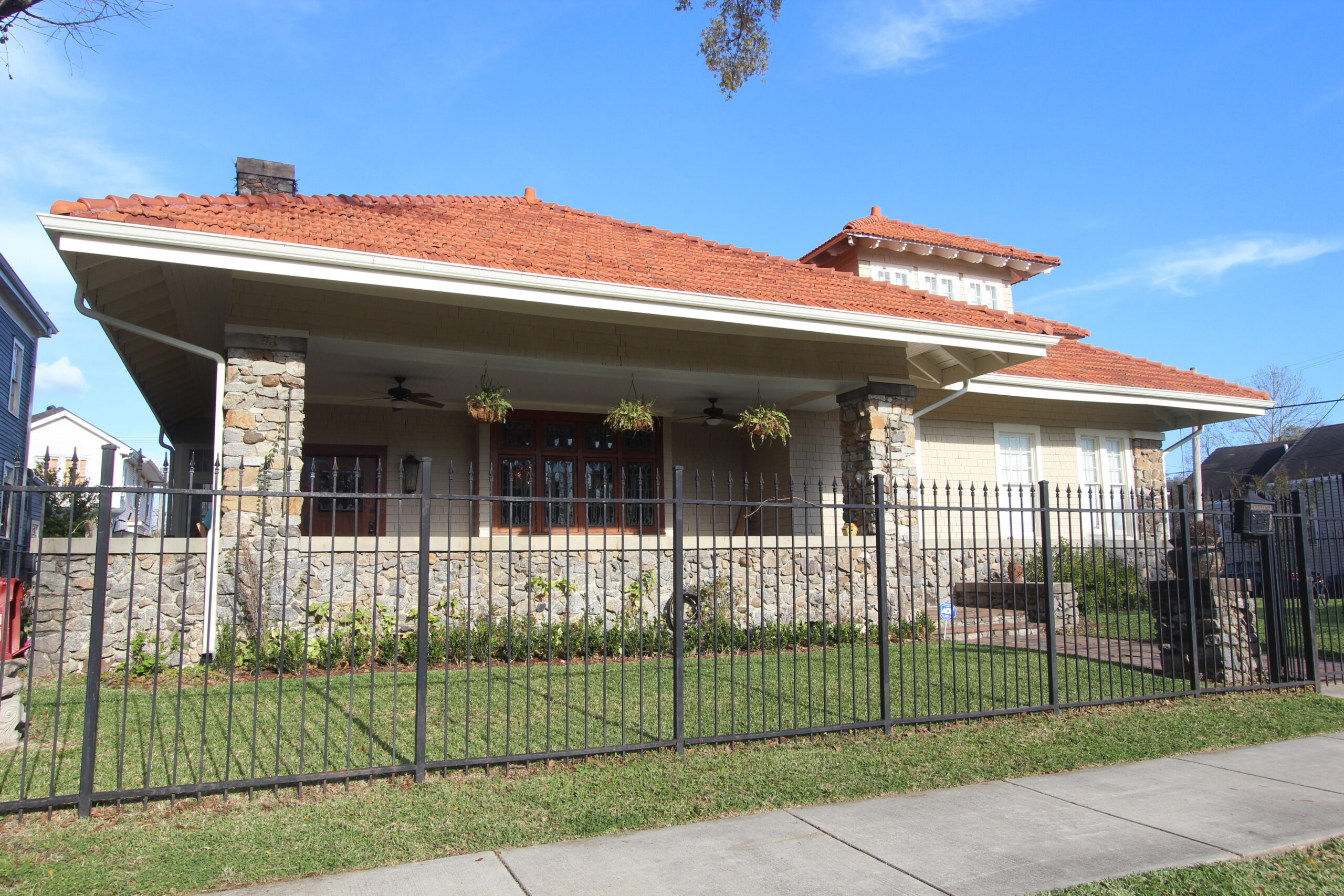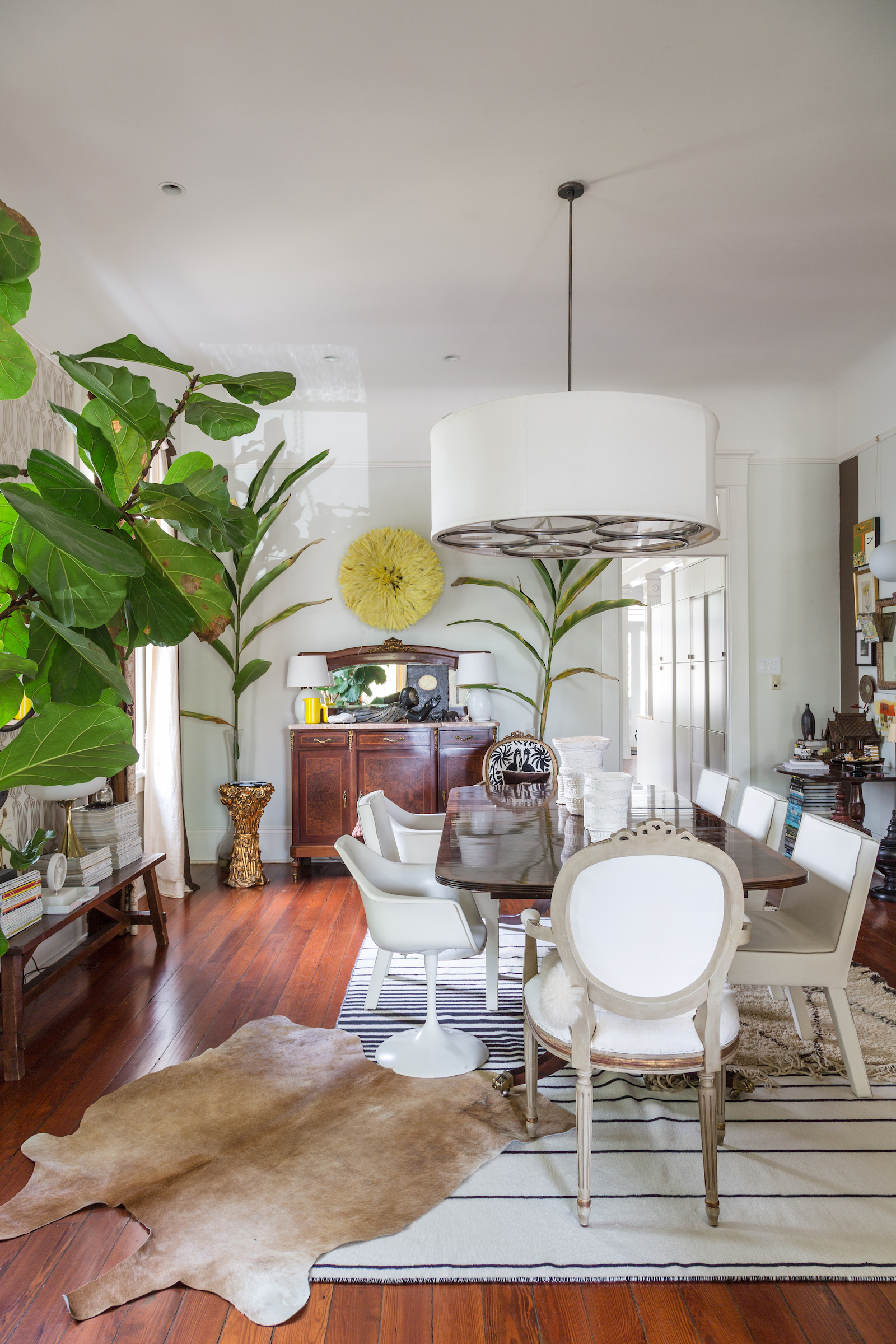Its history is storied, but many don’t know it, as the Pythian building was masked — literally — for decades, a mid-century modern sheath covering the 1909 gem underneath. When local development firm Green Coast Enterprises decided to purchase and renovate the structure into a mixed-use building with a fresh food market, health care and business offices, and 69 apartment units, their first step was to uncover the hidden gem: the metal sheathing came off, and the building’s beautiful brick façade shone once more for New Orleanians to enjoy.
Construction has taken less than two years to transform the building, but figuring out how to financially, architecturally and structurally complete such an extensive renovation took Green Coast Enterprises Principals Will Bradshaw and Lex Kelso and their many development partners five arduous years.
It was worth it. What was originally built as the Pythian Temple at 234 Loyola Ave. will soon be vibrant once more. Greats such as Louis Armstrong once wandered its halls; the building is now poised to once again attract and nurture cultural, political and business prowess for the city of New Orleans.
“To restore the Pythian to its former majesty, you have to do more than just physically renovate the building, because its true essence is in what it brought to the community,” said LaToya Cantrell, New Orleans Councilmember for District B. “With careful and thoughtful planning, Green Coast has developed a project that not only celebrates the Pythian’s history, but also renews its commitment to bringing people together.”
•••
The Pythian Temple has a history of remarkable local significance, beginning with its construction. Smith Wendell (S.W.) Green, then the most prominent African-American businessman in New Orleans, commissioned the construction of the Pythian Temple in 1908. Green had been born into slavery but was freed in adulthood and amassed a fortune of more than $10 million as a grocer, and subsequently as president of the Liberty Independence Insurance Company. He commissioned the building as the International Grand Chancellor of the Knights of Pythias, a fraternal organization that had been established by act of U.S. Congress in 1864 to unite the nation, then torn apart by the Civil War. Their motto was “Peace through Understanding,” and President Abraham Lincoln praised the organization and their ethos.
According to writer Lili LeGardeur, the group functioned as a benevolent association that paid its members benefits upon their death, an arrangement that meant the group functioned as part co-op, part life insurance company. The Grand Lodge, which was to be located on the corner of Gravier and Saratoga streets (now Gravier and Loyola), and would serve as an incubator for African-American business, politics and culture in early 20th-century New Orleans.
“To restore the Pythian to its former majesty, you have to do more than just physically renovate the building, because its true essence is in what it brought to the community,” said LaToya Cantrell, New Orleans Councilmember for District B. “With careful and thoughtful planning, Green Coast has developed a project that not only celebrates the Pythian’s history, but also renews its commitment to bringing people together.”
The seven-story Temple was made of steel — a building material just being perfected at the time, making this structure cutting edge — and clad in tan magnesium pressed brick and terra cotta. It was designed by Diboll, Owen and Goldsmith, and the popular publication Architectural Arts and Its Allies magazine featured the building’s architectural plans in March 1908. The façade featured grand stone entrances topped with plaster cartouches holding symbolic figures, and three prominent archways spanning the mezzanine and second floors. Brick fanned above windows on the ground and second floors in artful sunbursts.
The Pythian Temple was dedicated in 1909, and its construction was a significant feat for the African American community, both locally and nationally. The Times-Picayune called it ‘the biggest business enterprise ever attempted by the colored race in the United States,’ according to historian Keith Weldon Medley, and the Indianapolis Freeman hailed it as “the Greatest Building in the History of the Race.” “The Pythian Temple became the site of many New Orleans institutions,” Medley wrote in his book Black Life in Old New Orleans, and fostered the advancement of African-American life in significant ways. It housed a bank on the ground floor and shops, business and law offices that catered to, and were owned by, African Americans. Guillaume College operated from the Pythian Temple and offered business and secretarial courses at night, as well as preparatory classes for taking government tests. In 1925, the newspaper The New Orleans Herald-Louisiana Weekly, precursor to The Louisiana Weekly, was founded there. It also held the offices of the Industrial Life Insurance Company of Louisiana and the Peoples Benevolent Industrial Life Insurance Company, where Homer Plessy, of the landmark Plessy v. Ferguson U.S. Supreme Court case, worked. The Negro Board of Trade was located within the building, as was the office of the New Orleans chapter of the NAACP. It was a place where African-American fraternal organizations and clubs gathered.
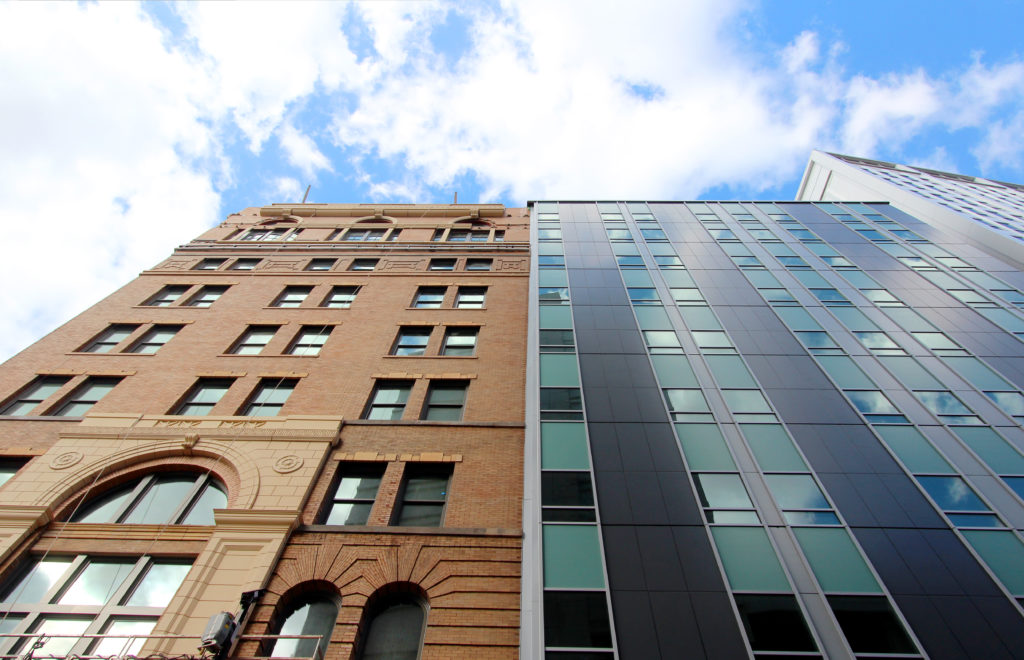
It’s a renovation of a rare kind: The front façade of the Pythian has been restored to match its 1909 appearance, and the back of the building mirrors its 1961 appearance. | Photo by Liz Jurey
A combination theater/auditorium on the second floor known as the Temple Theater hosted popular performing groups, vaudeville shows and African-American carnival balls. That venue, Medley says, “led to the formation of the Zulu Parading Club in 1909.” In 1923, an eighth and ninth floor were added to the structure; soon after, a rooftop bar opened. For a time known as “Piron’s Garden of Joy,” the venue hosted — and fostered the development of — prominent musical acts, including Louis Armstrong, Manuel Perez, Manuel Manetta, and others. “It was the most elegant venue in town that catered to African Americans,” LeGardeur wrote in a December 2004 article in The Louisiana Weekly.
“To a generation whose parents and grandparents had known slavery, the new edifice was an important accomplishment in the heart of the business community of a growing city,” she wrote.
It also laid the groundwork for what we now know as the Civil Rights Movement, said Will Bradshaw, principal of Green Coast Enterprises. “The building [and the meeting spaces within it] was central to the planning of the streetcar boycott in the teens,” he said. “Though that was unsuccessful in many respects, it laid the groundwork for what became the bus boycotts of a generation later.
“It was a place to provide a sense of opportunity, promise and possibility for a community that was otherwise demeaned and pushed down in every aspect,” he said. “This building stands as a monument and legacy to that strength and incredible perseverance, and a celebration of the cultural accomplishments of that community despite segregation and Jim Crow.”
•••
The Knights of Pythias, facing financial catastrophe in the wake of the Great Depression, lost the building by court order in 1941. Higgins Industries leased the building in 1943 as its hiring center, and made some decorative modifications to the building, but largely left the structure, and the five-story parking garage that had been constructed behind it in 1925, intact. New Orleanian Andrew Higgins had invented the “Higgin’s Boat,” a landing craft for vehicles and personnel that was so significant that President Dwight D. Eisenhower later described Higgins as “the man who won the war for us.” By 1943, Higgins Industries operated seven manufacturing plants and employed 20,000 people. Notably, the company employed the first fully integrated workforce of African American and white men and women in New Orleans.
Higgins Industries closed its offices at the Pythian Temple after the end of World War II in 1945. A subsequent owner, in 1957, decided to modernize the façade of the building to match the recently built New Orleans City Hall. An aluminum and porcelain ‘slipcover,’ or cladding, was installed atop the building’s original façade. In 1961, the five-story parking garage was raised to nine stories and clad in the same slipcover so that the two buildings matched. At that time it was known as the Civic Center Building; for four decades it housed a district court, a bank and medical offices.
Will Bradshaw and Lex Kelso first toured the building in 2012. It had been vacant for over a decade at that point, and was in poor shape. It had gone through so many owners and iterations that very little of the historic interior of the building was left; on the outside, the mid-century modern exterior looked sad and aged. The owner at that time used it to store building materials, among other things. “We walked in and there must have been a thousand toilets on the first floor,” Bradshaw said. “But then we came into the second floor and saw the arched windows and the brick, with a view onto Duncan Plaza, and we thought, ‘Oh, this is the building.’” Despite the metal cladding on the building’s façade, it was clear that the arched brick window openings of the Pythian’s past lay underneath, giving Bradshaw and Kelso hope for what a renovation could look like.
The second floor, future home to a jazz club, has great views of Duncan Plaza and City Hall through the building’s arched windows. | Photos by Liz Jurey
The two were looking at sites across New Orleans for their next big project. Green Coast Enterprises had already won awards and accolades for transforming vacant historic buildings at the intersection of Washington and Broad streets into revitalized offices, eateries and a health clinic for the Broadmoor neighborhood. They had also restored historic homes throughout the city as rentals, and constructed dozens of new, energy-efficient home builds in Gentilly, among other projects. “We always approach projects with a triple bottom line,” Bradshaw said: “What’s good for the community, what’s good for the environment, and how can we make a profit.” The duo knew nothing of the building’s history when they first considered buying it. What they did know, however, was that the building’s downtown location, close to the medical center, public transportation and amenities, would make it an ideal place to consider developing residential and commercial space in a way that benefited future residents, and the city as a whole.
They learned of the origins of the structure as they were trying to purchase it, and were amazed by its historic significance. “If you’re going to redevelop the Pythian, you have an extraordinary responsibility to honor the legacy of what came before you,” Bradshaw said. The Green Coast team developed a plan where the first floor of the building would house a food market, and floors above would house business and medical offices and 69 apartments, 25 of which would be designated as “permanently affordable.”
“Most of the people who work downtown make $35,000 to $70,000 a year,” Bradshaw said. But those people can’t live downtown: They can’t live in subsidized units because they make too much, and they can’t live in un-subsidized units because they don’t make enough. “So you have half of the workforce that is effectively excluded from the downtown housing market.” Though the number of residential units downtown is growing, occupancy is still at 98 percent, meaning that most developers aren’t incentivized to make units affordable. They can and do garner market rate rents.
The redevelopment of the Pythain honors the building’s past. The affordability of one-third of the building’s residential units “represents the economic diversity of the city,” Bradshaw said. The food market, which will offer a variety of kiosks for hungry patrons, will also function as an incubator for local entrepreneurs. GCE also hopes to open a jazz club on the second floor. These endeavors represent the company’s “commitment to culture,” Bradshaw said, “and tells part of the story of what was here originally.” Tenants will also include a community health center and a physical therapy clinic, among others.
“This is a building that is about, and for, New Orleans,” he said. But before this vision could be executed, Bradshaw had to perform what can only be described as wizardry in lining up funding to finance the $43 million building transformation.
•••
The first task to making the redevelopment of the Pythian financially possible was the assurance that the project would earn state and federal historic rehabilitation tax credits. In Louisiana, the two credits combined earn developers 45 cents on every dollar spent, which they can deduct from their taxes or cash in for capital through certain banks and companies. It was here that GCE hit their first major obstacle — one that took two years of onerous work to solve.
Despite the building’s incredible historic significance, it had been excluded from the boundaries of the Lower Central Business District National Register district. The boundary had last been expanded in 2006, said Gina LaMacchia, development manager with Green Coast Enterprises. But the Pythian’s mid-century cladding — a false façade — had excluded the building from National Park Service (NPS) attention. If the building wasn’t listed as individually significant, or located in a National Register Historic District, it couldn’t earn tax credits — and the redevelopment dream would be dead before it began.
LaMacchia, Bradshaw and Kelso were confident that the Pythian’s significant history would convince the NPS to take a second look. They also hypothesized that the building’s original façade was sitting beneath the metal cladding — and if it was, that could get the building included on the National Register for sure. “We first tried to get the building individually listed as significant,” LaMacchia said. The first step in that process: remove the metal cladding so that the Pythian would be recognizable from the era of its original construction. “We spent about a quarter of a million dollars just removing the façade before we purchased the building,” LaMacchia said. It was a huge gamble; “we had no idea what we would find,” she said. “We knew from the inside that there were gorgeous archways, but it was a surprise to all of us how beautiful the building ended up being.” The Louisiana State Historic Preservation Office (SHPO) unanimously approved the building’s listing on the National Register of Historic Places, “but when it went to the federal reviewer in Washington, DC, we were denied because of a lack of interior integrity,” LaMacchia said. Too much of the building’s interior had been stripped away through the years; the physical representations of the history that made the building so significant were gone.
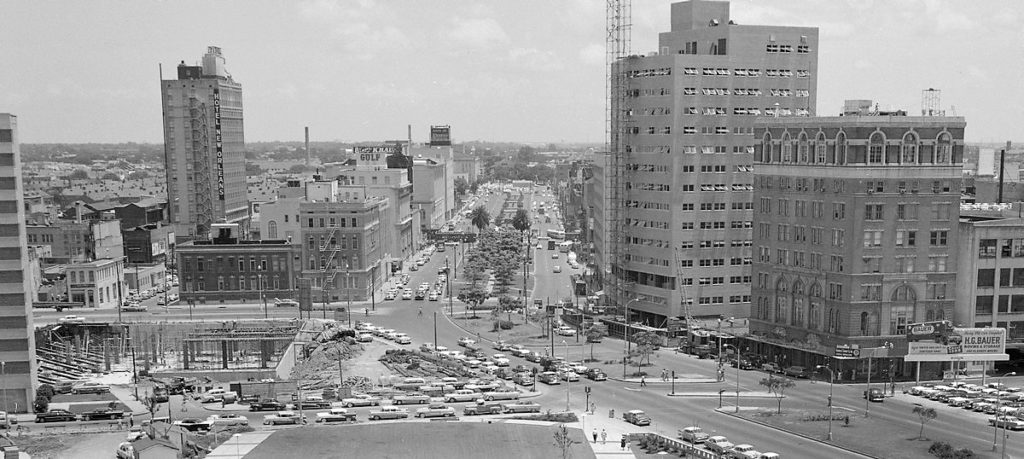
This photograph shows the building on the right, and the construction of the New Orleans Public Library Main Branch on the left.
The GCE team, upset and nervous that they were about to lose on their gamble, started calling preservationists across the country. “The National Park Service and SHPO suggested we expand the federal historic district instead,” LaMacchia said. Expanding the Lower Central Business District National Register district didn’t just mean making a case for the Pythian, however. Instead, an update on every building in the district would be required.
LaMacchia got to work, along with coworker Stephanie Mezynski. “We did research on any building on the block that was formerly considered non-contributing to update them and see if they were now eligible,” LaMacchia said. Jessica Richardson from the Louisiana SHPO helped with the monumental task.
The district expansion was accepted in January 2015, but what the National Park Service and SHPO decided GCE should do with the building surprised everyone. To earn historic rehab tax credits, the Pythian would need to be restored in the front to match its original 1909 construction— with the exception of a cantilevered cornice that projects from the building five feet, which was originally added in 1923 and will now be reinstated. And since the back addition to the building was constructed in 1961, it is over 50 years old, and technically historic. So the addition was to be restored to its 1961 look; the building is classical in the front, mid-century modern in the back. To a passerby on the street, it looks like two separate buildings. Inside, however, visitors can pass from the early 20th-century Pythian to the 1960s addition without realizing it.
“The support we had from the community was amazing,” LaMacchia said. “Everyone recognized that this was a project that needed to get done, for preservation reasons, for affordable housing reasons. We just had to find the right pathway. Ultimately it was the NPS and the SHPO that figured out this pathway; this would not have been possible without them.”
With the significant historic rehab tax credit funding finally secured, it was time to find tax credit investors and solidify the project’s other financial backers — a process that, once again, presented surprises.
•••
Lining up different funding sources to cover a $43 million renovation was indeed as complicated as one might assume. Investors had to be found for the historic tax credits as well as New Markets tax credits, which are notoriously tricky to earn. Investors with capital had to be sourced, as did banks that would take on the loans.
Barrett Cooper, chief operating officer of ERG Enterprises, became interested in the project after reading about it in the newspaper. He had long known and respected Bradshaw, and gave him a call. ERG, founded in 2006, focused in its early years on investing in health care facilities, as its founder, Dr. Eric George, is a renowned hand surgeon. In recent years the company has branched out, however. The Windsor Court and Royal Orleans hotels were early investments, and most recently, ERG was 50 percent owner and developer of the Orpheum Theater. They also recently partnered in the reopening of the Pontchartrain Hotel. “We love unique, historical, cultural entities, from a real estate perspective,” Cooper said. “Our investment belief is that there’s more sustainability both financially, structurally and in the community from historic buildings. Historic projects have value; there’s a value having people come to us and say, ’50 years ago we used to have Sunday lunches in this place, and we feel attached to it.’ It’s community, but it’s also sustainability financially. You don’t have to rebrand things — people know what it is.”
ERG was already sold on Bradshaw and GCE’s work, as well as the importance of the Pythian’s history. What clinched it for the company, Cooper said, and caused them to become a partner and investor in the Pythian, was the building’s location. Situated downtown, across from City Hall and close to the new hospitals, the prime locale, coupled with catalytic improvements undertaken by the City, such as the installation of a streetcar on Loyola Avenue and upcoming improvements to Duncan Plaza, really made the project a win, Cooper said.
This commitment to offering more than just market-rate units attracted another investment partner, the Crescent City Community Land Trust. The community development corporation (CDC), which was started in 2011, focuses on partnering on residential and commercial projects that bring permanent affordability to tenants and owners, in addition to educating the community and promoting affordability through policy. Partnering on the Pythian will be their signature project, said Executive Director Julius Kimbrough, Jr. “The reality of life in New Orleans is that ‘low to moderate-income’ often means African American,” he said. “The Pythian was historically a building for and by African-Americans. It’s a beautiful circle.”
“Our investment belief is that there’s more sustainability both financially, structurally and in the community from historic buildings. Historic projects have value; there’s a value having people come to us and say, ’50 years ago we used to have Sunday lunches in this place, and we feel attached to it.’ It’s community, but it’s also sustainability financially. You don’t have to rebrand things — people know what it is.”
“We are about connecting people’s housing with their lives beyond the house,” Kimbrough said. “The need for a doctor, a grocery store, [proximity to] major transportation networks. The Pythian is in downtown New Orleans, and Tulane and Loyola Avenues has become the major terminus fro the RTA system in this town now,” he said.
CCCLT has partnered to bring debt and equity to the transaction, acting as a co-developer and a financier.
Other stalwart partners that made the project financially feasible, according to Bradshaw, include U.S. Bank, Iberia Bank, The Reinvestment Fund, the National Trust Community Investment Corporation, Willowend Investments and Gene Kelso Caselli. Bradshaw and Lex Kelso were also personal investors.
•••
It took years for tax credits and finances and partners to be sorted out; all the while, skilled architects at studioWTA were diligently working on the project, too. While GCE’s LaMacchia described what was left of the original façade when the metal sheathing was removed as ‘beautiful,’ studioWTA architect Scott Crane remembers differently. “When the façade came off, there was a collective gasp in the office,” he said. The façade’s original brick and plaster had been shaved from 3-D to 2-D to hang the new, mid-century sheathing, and the brick that remained was “pock marked” and unusable, he said.
But GCE was committed to restoring the façade as it originally looked. “The developers wanted to do the right thing,” said studioWTA Principal Wayne Troyer. “They didn’t cheap out at all.”
The architects, under the leadership of Troyer and Julie Babin, used the Pythian Temple’s original architectural plans as a guide map to recreate the façade. “But some of the details just weren’t there,” Babin said, so the team had to rely on photographs, and even historic articles and documents, too, to decipher exactly what the original façade looked like, down to the finest detail.
In the building, they had some guidance. Though the brick on the first two floors was unsalvageable, their presence made exact replication of their patterns possible. New brick did have to be sourced, and special effort was made to match the color and speckling of the original brick, which was largely salvageable above the second floor.
But some missing details remained a mystery. Large plaster cartouches above the two ground floor entrances, for example, are undecipherable in renderings, so studioWTA worked with plasterer Jeff Porré to design new cartouches to top the stone-surrounds that define the front entrances. The new cartouches blend the old with the new: in honor of the new food market, Louisiana produce and seafood figures frame the cartouche and surround the original Knights of Pythias seal in the middle.
How to fit 12 apartments on every floor above floor 4 was a challenge, Babin said, while working within the confines of existing structural columns and window placement. Another challenge was how to design apartments on the luxurious ninth penthouse floor given that much of the floor had large, plaster barrel vaults across the ceiling. “Running plumbing and lighting without ruining those spaces was tricky,” she said.
The team fought hard to keep the few remaining original architectural details they found within the building. The stair rail, for example, features a beautiful swirling design, and is original. But it doesn’t meet modern-day safety code. “We all felt very strongly from the beginning about keeping them,” Babin said. “Wayne and I went to Baton Rouge to appeal to the state fire marshal’s office, and we had an appeal with the City of New Orleans to keep the stair in its existing form and to not have to dramatically modify it. And our effort was successful.”
They also opted to keep the building’s steel beams exposed instead of encasing them in drywall, as is typical. “This was a steel-frame structure, [a building type that] was just being developed in Chicago,” Troyer said. “So the original architects were very on top of technology.” That led studioWTA and GCE to agree that keeping the steel beams exposed was not only a cool look, but had historic meaning. The beams were coated with intumescent paint to make them fireproof, and are now visible for all to see.
Elizabeth Simpson with studioWTA analyzed paint samples to glean what the interior’s original colors were, and then recommended matches from Benjamin Moore, giving the building a historic palette.
“A successful project is the result of the combination of an enlightened owner, a talented architect and an engaged contractor,” Troyer said, “and the Pythian had all three.” GCE and studioWTA worked closely with Landis Construction, the project’s contractor, to achieve great results. “Landis stepped up, and Will and Lex are one of best development teams I’ve ever worked with,” Troyer said. Bradshaw echoed his sentiments. “In 20 years, I’ve never worked with a better development team than the one on this project,” he said.
Residents are scheduled to start moving in to the Pythian on April 1, and the rest of the commercial spaces, including the new ground-floor market, will be opening through the fall.
Photos by Liz Jurey
Join us for a free Renovator’s Happy Hour at the Pythian on Thursday, April 6



